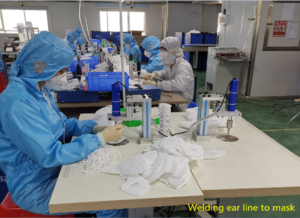Dear All,
I hope that all of you are well and keeping your businesses and home lives seamed together during these challenging times. Like many of you, I’m staying close to home and doing my best to move the ball down the field.
While many of our customers have gone virtual, several continue to operate and manufacture essential products. I spoke last week with the purchasing manager of an electronic sensor business and he showed me around their plant by Facetime. They’ve moved from a one-shift operation to two, in order to distribute the staff and maintain a safe distance. Every other workstation has been taped off, and in the break area, the long tables that normally accommodate eight people are now limited to two. A creative and useful approach to continue serving their customers and employing their staff.
On-Site Factory Audits
With the rush to bring on new vendors (including many PPE suppliers) to maintain continuity of supply, we’re being slammed with requests to audit candidate factories. Please see ear loops being welded to KN95 masks at a factory that we recently audited.

General & Comprehensive on-site audits can usually scheduled with one or two days notice and ISO13485 FDA audits within four or five. Suddenly, everyone wants the audits to be carried out yesterday… We’re trying and also need to be sensitive to the factories’ production schedules, so I ask that you please be patient with all of us.
Building Prototypes
One element of the new product development and industrialization process that’s marching forward is engineering and fabricating factory prototypes. This follows the handcrafting of functional or “looks like-works like” models by the design team.
New product models usually incorporate a mix of components and materials that lend themselves to building a handful of “voice-of-the-customer” units. They rely on breadboarding, 3D printing, soft materials, “close enough” components and the ingenuity of the engineers and industrial designers who conceive the design. The professionals who do this kind of work are indispensable and are the midwives that bring new products into being.
While this is an essential step in generating proof of concept, these hand built models don’t provide a road map to follow for scaling up to mass production. That requires the touch of industrial engineers, manufacturing engineers, technicians and production specialists, who deeply understand material & methods and live & breathe volume.
This group takes the hand-off from the design team and starts the process of building production-ready units. What emerges from this complex effort is summarized below:
- Finalize Bill of Materials (BOM) and convert concept drawings to engineering drawings
- Negotiate supply contracts and pricing for components, materials and subassemblies
- Establish machine settings and process parameters (Process Flow Chart)
- Identify and qualify a corps of subcontractors
- Coordinate Design for Manufacturing and Assembly (DFMA) in concert with the design team.
- Design and build test fixtures, jigs & fixtures, molds and tooling
- Draft shop floor drawings, production travelers and Standard Operating Procedures (SOPs)
- Review applicable international certifications, specifications, safety standards and generate a Quality Control Plan
- Build the DVT Samples DVT
- Prepare a logistics, fulfillment and warehousing plan
Cheers,
Jack Daniels
+1.617.285.2486
